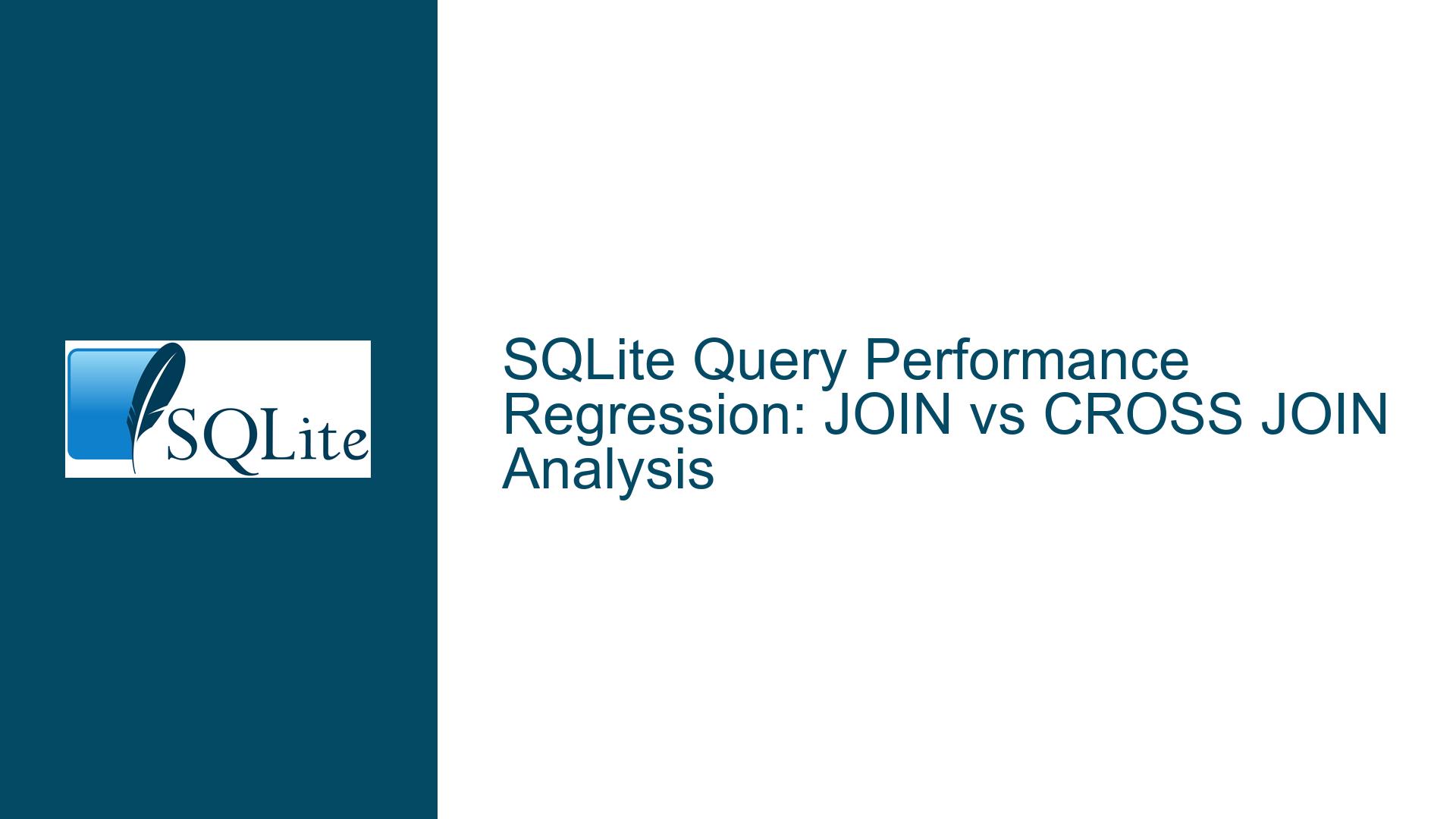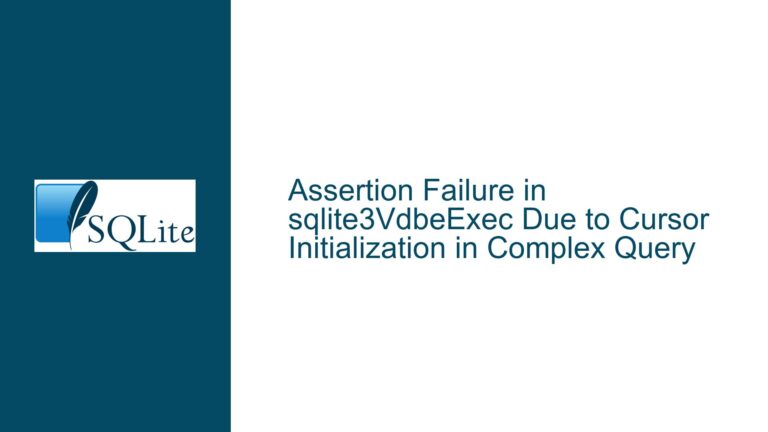SQLite Query Performance Regression: JOIN vs CROSS JOIN Analysis
Understanding Query Performance Degradation in SQLite 3.47+ Joins
A significant performance regression has emerged in SQLite versions 3.47.2 and 3.48.0, specifically affecting complex queries that utilize multiple inner joins to combine results from tables and views. The regression manifests as a dramatic slowdown in query execution times, where operations that previously completed in under one second on version 3.46.1 now experience substantial delays.
The core issue centers around SQLite’s query planner behavior changes in newer versions, particularly affecting queries with the following characteristics:
- Queries combining multiple tables and views through inner joins
- Presence of procedural tables or table-valued functions
- Scenarios involving non-materialized sub-queries dependent on earlier join results
- Cases where indexed tables appear later in the join sequence
The performance degradation appears to stem from the query planner’s decision-making process regarding join order optimization. In versions 3.47.2 and later, the planner may inappropriately promote indexed tables above procedural tables in the execution sequence, even when these indexed tables don’t have dependencies on the procedural table’s output. This promotion triggers unnecessary recursive CPU usage, resulting in exponential performance degradation.
A particularly problematic scenario occurs when the query involves table-valued functions like json_each or similar procedural operations. The planner’s attempt to optimize based on available indexes can lead to repeated evaluation of these functions, creating a cascade of inefficient operations. This behavior represents a departure from the more straightforward execution path observed in version 3.46.1.
Initial investigations have revealed that replacing INNER JOIN with CROSS JOIN statements can effectively mitigate the regression. This workaround forces a specific recursion order, preventing the query planner from making potentially suboptimal choices. While this solution successfully restores performance to previous levels, it raises questions about the long-term implications for query optimization and maintenance.
The regression’s impact is particularly concerning for applications that:
- Rely heavily on view-based architectures
- Implement complex join operations across multiple tables
- Utilize table-valued functions or procedural tables within joins
- Depend on consistent query performance across SQLite version updates
This issue has prompted some developers to either remain on version 3.46.1 or implement structural changes to their database schemas, such as materializing views into tables and creating additional indexes on joined columns. However, these adaptations may not be ideal for all use cases, especially in scenarios where view flexibility and storage efficiency are crucial requirements.
The performance regression highlights the delicate balance between query planner optimizations and predictable query execution patterns, suggesting a need for careful consideration when upgrading SQLite versions in production environments where complex join operations are central to application performance.
Analyzing Causes of SQLite JOIN Performance Degradation
The performance regression in SQLite’s query execution stems from several interconnected factors affecting how the query planner handles joins and optimizes execution paths.
Query Planner Behavior Changes
The query planner’s decision-making process has evolved significantly across versions, particularly in how it handles index utilization during join operations. When dealing with indexed tables appearing later in join sequences, the planner may inappropriately promote these tables above procedural tables, even when such promotion creates inefficient execution paths. This promotion can trigger unnecessary recursive CPU usage, leading to exponential performance degradation.
Cache and Memory Management Impact
SQLite’s performance is heavily influenced by cache size and memory management, especially when dealing with indexed operations. The cache can quickly become saturated when handling complex joins, particularly if the indexed columns consume significant cache space. This situation becomes more pronounced with larger datasets, where the performance impact of index usage may actually degrade rather than improve query execution times.
Join Type Implementation Differences
The internal implementation of different join types affects performance in distinct ways:
| Join Type | Performance Characteristics | Common Issues |
|---|---|---|
| INNER JOIN | Generally efficient for matched records | Can suffer from poor index utilization |
| CROSS JOIN | Creates Cartesian products | Resource-intensive but sometimes faster |
| LEFT JOIN | Requires additional processing | More susceptible to planner mistakes |
View-Related Complexities
Views introduce additional complexity to query optimization, particularly when combined with joins. The query planner must make decisions about materializing views and managing temporary results, which can lead to suboptimal execution plans. This becomes especially problematic when views are used in conjunction with complex join conditions or when multiple views are involved in a single query.
Index Utilization Challenges
The effectiveness of indexes varies significantly based on:
- Database size and growth patterns
- Join complexity and conditions
- Cache availability and management
- Data distribution across joined tables
Query Complexity Impact
As queries become more complex, particularly with multiple joins and views, the likelihood of performance degradation increases. This is especially true when:
- Multiple tables are involved in join operations
- Complex filtering conditions are present
- Views are nested or chained
- Large result sets need to be processed
The combination of these factors creates scenarios where the query planner’s decisions may lead to significant performance variations between SQLite versions, particularly when dealing with complex join operations involving views and indexed tables.
Implementing Performance Optimization Strategies for Complex SQLite Joins
Immediate Performance Solutions
The most effective immediate solution for addressing join performance issues involves utilizing CROSS JOIN syntax to enforce specific execution order. This approach prevents the query planner from making potentially suboptimal choices in join ordering, particularly when dealing with procedural tables or table-valued functions. When implementing CROSS JOIN, the table positioned to the left becomes the outer loop relative to the table on the right, providing predictable query execution patterns.
Query Analysis and Optimization
Before implementing any changes, utilize the EXPLAIN QUERY PLAN command to analyze current query execution patterns. This diagnostic tool reveals potential bottlenecks and helps identify where performance optimizations will have the most impact. The analysis should focus particularly on join operations and index utilization patterns.
Index Implementation Strategy
Create targeted indexes based on join conditions and query patterns:
| Index Type | Use Case | Performance Impact |
|---|---|---|
| Single Column | Basic filtering | Good for simple queries |
| Composite | Multiple join conditions | Optimal for complex joins |
| Covering | Complete result retrieval | Eliminates table lookups |
Query Structure Refinement
Restructure queries to optimize performance by implementing these technical approaches:
Materialization Control
Use the MATERIALIZED keyword for Common Table Expressions (CTEs) that are referenced multiple times in complex queries. This prevents redundant computations and ensures efficient data access patterns.
Cache Optimization
Implement proper cache management strategies by:
- Adjusting cache size settings for optimal performance
- Monitoring cache hit rates
- Managing memory allocation for complex join operations
Join Operation Optimization
When dealing with multiple joins:
- Position smaller result sets early in the join sequence
- Use appropriate join types based on data relationships
- Implement proper filtering before join operations
Performance Monitoring Framework
Establish continuous monitoring using SQLite’s built-in tools:
- Regular query plan analysis
- Performance metrics collection
- Execution time tracking
Schema Optimization
Consider strategic denormalization where appropriate to reduce join complexity. This approach can significantly improve query performance by reducing the number of necessary join operations while maintaining data integrity.
Query Planner Guidance
In cases where the query planner makes suboptimal choices, implement specific guidance:
- Use INDEXED BY syntax for critical queries
- Apply strategic table hints
- Implement forced materialization where beneficial
The combination of these strategies creates a robust framework for maintaining high performance in complex SQLite implementations. Regular monitoring and adjustment of these optimizations ensure sustained performance improvements over time.






